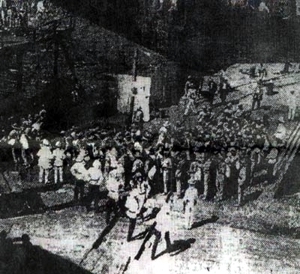|
Press Clippings
Jamaica and the Great War
On August 5, 1914, England declared war on Germany not long after the assassination of the heir to the Austrian throne. Submarines, tanks and dreadnoughts appeared on the world stage, ushering in a new stage of warfare. There was never any doubt that Jamaica would show solidarity with the rest of the Empire. So on November 8, 1915, Brigadier General Blackden sent off the first Jamaican contingent under the command of Major W. D. Neish to serve in the First World War. As the band played Soldiers of the King, and prayers for their welfare and safe return home were said, 500 men sailed slowly off into the unknown looking for adventure, a chance to serve God and country. The world had been at war for over a year. Recruiting meetings were held in each parish. Public calls to duty were listed in newspapers following glowing commendations on the services of Jamaican units of the British West Indies Regiments eleven battalions. Every man who went to the front from Jamaica was a volunteer and most were between the ages of 19 and 25. Many went out of patriotism, but just as many went out of a desire to simply ‘get out’ and start a new chapter in their lives.
Together, soldiers from the West Indies represented sons of gentry and sons of labourers. There were lawyers, doctors, engineers, farmers, carpenters, clerks, blacksmiths, shoemakers, tailors, mason, printers, builders, coachmen and grooms. The troops were trained in English camps their long spells of work broken by competitive games of cricket and football. They saw action in Africa, Europe, the Mediterranean and the Middle East. The 2nd Battalion of the West India Regiment (now established for over 100 years) gained yet further Battle Honours in Belgium, France, Italy, Egypt and Palestine. Jamaican women did their part, too. They organized Flag Day fundraisers, a
War Relief Fund and sewed woolen garments for soldiers. In addition to the
women’s funds, there were others including the Gleaner Fund and Palace
Amusement Co.’s Palace War Fund. Thousands of pounds were collected. Over
4000 packages of fruits, 71 bags of sugar, 49 cases of ginger, four casks of
rum, and two cases of playing cards were shipped to military hospitals, and
distributed locally to men manning Jamaica’s coastal forts. The British West India Regiment (BWIR)
The British West India Regiment (BWIR) was known as a ‘coloured’ regiment and as such was often the victim of racial discrimination. Eugent Clarke, a Clarendonian BWIR veteran, who in 1999 at the age of 105 received France’s Legion d’Honour for meritorious service in WWI, remembered when his ship had to put in at Halifax in Nova Scotia due to the dominance of German ships in certain waters. Many members of the BWLR had their first contact with snow and frostbite. They remained clothed in tropical lightweight khaki uniforms, denied issue of the heavier weight uniforms of British soldiers until half of the battalion had already died. Clarke was one of 200 lucky survivors. The men of the BWIR were generally restricted to carrying out hard labour, digging trenches, carrying supplies to men at the fronts. Some, mainly those stationed in the Middle East, were allowed to serve as combat troops. In the meantime all continued to suffer from severe weather conditions, frostbite, measles and mumps. One thousand of the over ten thousand that left Jamaica never returned.
Mutiny of the BWIR
Thousands of BWIR troops were held for close to a year by the British War
Office at a camp in Taranto, Italy. Clarke and his fellow BWIR soldiers were
virtually kept prisoner in large barracks which On December 6, 1918 tensions at Taranto reached a boiling point and the
soldiers of the BWIR who did not understand why they had not been sent home
and wanted nothing more than to go home, mutinied. They attacked their
officers and severely assaulted their unit commanders, sending shock waves
throughout the British Army. After four days the mutineers surrendered and
the entire regiment suffered the humiliation of being disarmed. The
mutineers were severely punished, one was shot, one executed by firing squad
and another sentenced to time in prison. When the last of the BWIR troops
were finally repatriated in September 1919, they were accompanied by three
military cruisers in order to prevent unrest once the ships docked at ports
in Jamaica, Barbados and Trinidad. These BWIR soldiers were not given a
heroes welcome because there was simply great fear on behalf of colonials
that these soldiers, well-trained and now more politically aware, could
create havoc for the status quo under which colonial life was governed. In Memorial
Today, the Caribbean’s World War I veterans are well remembered in the
region, but not in Britain where a rewriting of history to include the
coloured man’s point of view is slowly taking place. War-time notes
In 1892, Lance Corpora] (later Sergeant), William James Gordon, of the First Battalion, The West India Regiment, received Britain’s highest and very rarely awarded gallantry decoration, the Victoria Cross (established in 1856), for saving the life of his commanding officer. Gordon is the only Jamaican to win the VC, and only the second non-white to receive it. Gordon died in 1922 and is buried at Up Park Camp. At the outbreak of the First World War in August 1914, the British War Office resisted acting on the numerous requests from men of the West Indies and other colonies to join up. It was not until a year later in 1915 when the casualties of trench warfare led to a shortage of soldiers that the War Office began to recruit heavily in the West Indies. It had been previously thought that guns and ammunition in the hands of black men would be a major mistake. A piece of ancient mosaic let into the floor of the Garrison Church at Up Park Camp is a reminder of service of Jamaica in the Holy Land during the First World War. It is from a piece of a mosaic unearthed by the firing of a Turkish shell at a British entrenchment at Ain Durk a few miles from Jericho. The Military Museum at Up Park Camp is open Mon to Fri 9 a.m. to 3:30 p.m. Call 926-8121 for more info. In the vestibule of the Institute of Jamaica is a small War collection of portraits of Commissioned Officers who fell, and objects connected with the various fronts. Norman Washington Manley was a decorated sergeant in World War I. His brother Douglas, died in service. Norman Manley would wear a black tie in memory of his brother for the rest of his life. The distinctive Zouave uniform worn by the West India Regiments was first issued in 1858. Queen Victoria was impressed by the uniform, of the Zoaves (a light infantry of North African origin) in a review of French colonial troops, and instructed that it be introduced into her army. An adaptation of this became the full dress uniform of the West India Regiment until the last of the regiment was disbanded in 1926 for reasons of economy. The Jamaica Military Band (which descends from the Jamaica Militia of 1662 and the band of the old battalions of the West India Regiment) still wears it today. Sources: F. Cundall, Jamaica’s Part in the Great War, 1915-1918. (London: IOJ, by the West India Commission, 1925), M. Needham for permission to use copyright material on the Jamaica Military Band and the Jamaica Regiment Band, M. Goodman and V Rushton. A Jamaica Past, being a Glimpse into History’s Last Surviving Bloodiest battlefields; A Visit with Jamaica’s Last Surviving World War I Veteran. Jamaican Historical Society Bulletin, vol II, (3), 52-57. The BBC, Channel 4, 3-part documentary, Mutiny 1999. |

